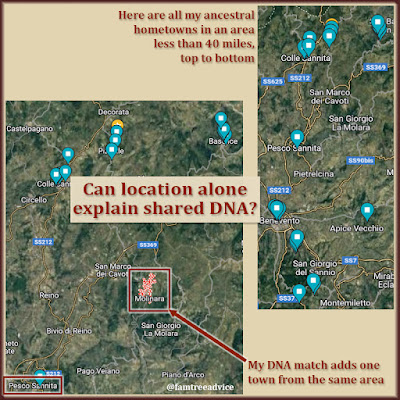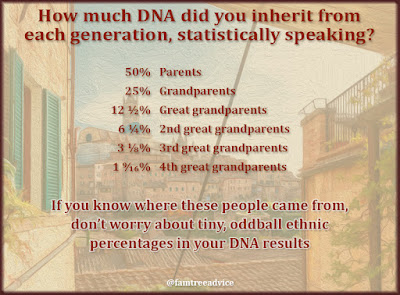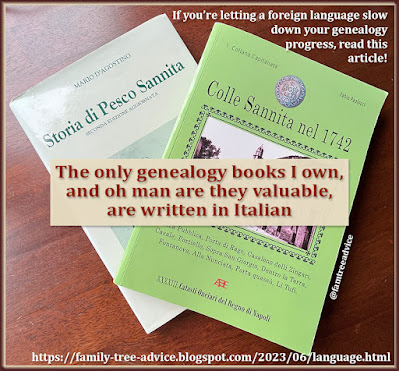I've recently added more than a thousand people to my family tree from one town—Pesco Sannita, Italy. And I've barely begun to harvest the vital records. I'm eager to use the new families in my tree to connect to my unsolved DNA matches.
That's the exercise for today. I went to my DNA match list on Ancestry and searched for people with the name Pennucci in their trees. I chose that name because it's common in the town and my 3rd great grandmother was a Pennucci. I selected the first match who wasn't my father or someone from his 1st cousin's family.
I've looked at this match's tree before. It's a good one—46,234 people. But checking how his ethnicity compares to mine, I see that he's only a quarter Italian. That means a big chunk of his family tree has no connection to me.
My jumping-in point in his family tree is his great grandmother Immacolata. I recognize my match's last name (it's also his great grandfather's name), but it doesn't come from my target town. His grandmother falls into the sweet spot. Her 1902 Pesco Sannita birth record is available on the Italian ancestry website, Antenati. (See "How to Make the Best of the New Antenati Website.")
I pulled up Immacolata's birth record and discovered she's in my tree already. She and I don't have a blood relationship. Immacolata (who's mother was a Pennucci) is the 1st great grand niece of the wife of my 4th great uncle. I've already built Immacolata's family tree back 5 or 6 generations. What more can I do to establish a true relationship to this DNA match?
I realized Immacolata is in my tree because of a previous attempt to connect to this DNA match. Now I need to search the vital records for her siblings, aunts, and uncles to see where it takes me.
I get the impression some people think the only way to use the Antenati website is to search for a name. Not true. Not every record is searchable. You need to navigate to your town and to each year's index pages to scour them for the name you want.
But I'm the lunatic who downloaded entire towns when it was possible. Then I renamed each document image on my computer to make them truly searchable. For me, it's easy to search the vital records for someone's siblings, and their parents' siblings.
Swimming in the Same Gene Pool
I built out several families related directly to Immacolata with no breakthrough. Then I looked at our original relationship: 1st great grand niece of the wife of my 4th great uncle. Immacolata's 2nd great aunt Agnese married my 4th great uncle Giuseppe. That's something like "crossing the streams" in the Ghostbuster movies. Their marriage created people who carry DNA like mine and like my match's.
What I haven't mentioned yet is that this DNA match, the great grandson of Immacolata, is in my 5th–8th cousin range. We share only one segment of 17 cM. Our shared roots are in a remote town where families intermarried for centuries. There's a very good chance that instead of a pair of shared ancestors, we have DNA from the same community pool.
I've been thinking about this notion for a long time. I haven't put it out there because it seems evasive and hard to put into words. It started taking shape when tests showed that my parents share DNA—37 cM across 4 segments. They could be 3rd to 5th cousins. But they aren't. I can name their ancestors and they're all different. (See "When DNA Says You're Related, You Determine How.")
Here's what I think. My documented ancestors, going back to the late 1600s, lived in neighboring towns, laid out like links in a chain. Each town is small, and even with modern roads, it can be hard to get from one to the next. (I know from personal experience.) That led to centuries of intermarriage within the towns or between close towns.
 |
| Doesn't it make sense that deep roots in a small geographical area result in shared DNA? |
All those neighboring towns produced generation after generation of people with shared DNA. You know how the big DNA companies compare your DNA sample to a reference panel? The panel consists of DNA from people with roots in one place for several hundred years. Well, that's me! Until my recent ancestors came to America, my people were tied to one spot for centuries.
Studies show that the characteristics of a place exist in its people's teeth and bones. Is that why you can "feel it in your bones" when you arrive at the place your ancestors came from? I believe my parents and I, and many of our distant DNA matches, share the characteristics of the place we come from. That's why we carry some identical DNA.
We've been simmering in the same pot for centuries!
My DNA match, great grandson of Immacolata, has DNA from a mixture of Pesco Sannita and a town 9 miles away—Molinara. I get all my DNA from a mixture of at least 7 towns in the same area. We have the very soil in common.
Adding Up Your Ancestral Roots
I took a tally of the birth places of my 1st through 3rd great grandparents—all 42 of them. Here's my percentage of roots in each town. (The 7th town, Circello, doesn't appear until a pair of my 4th great grandparents.)
- Colle Sannita 40.48%
- Baselice 23.81%
- Pastene 21.43%
- Pesco Sannita 7.14%
- Santa Paolina 4.76%
- Apice 2.38%
Seeing this list in order justifies the extensive research I've done. I've completely harvested the vital records of Colle Sannita and Baselice. I've worked everyone possible into my family tree. I've harvested Pastene's limited records, too. Now I'm working my way through Pesco Sannita. Obviously Santa Paolina and Apice will be next, then Circello.
This type of relationship to my distant DNA matches changes how I view them. I don't expect to find a common ancestor with most of them. But I do search their family trees for marriages without documentation. Immacolata and her family are in my tree, but there's no documentation of her marriage to a man from Molinara. It's my match's tree that holds that detail.
If your family tree has no non-parental events and few missing ancestors, you may ignore your DNA matches. I encourage you to review matches with decent-sized family trees. What are they good for? They may contain the marriage that brought your great aunt to a new country. They may help explain a great uncle who seemed to disappear from his hometown. They can extend your tree's dead ends.





